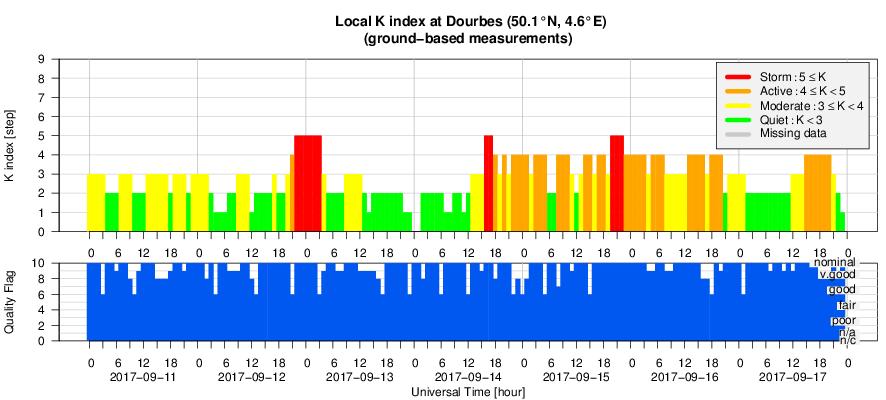- Table of Content
- 1.NOAA 2673's hi...
- 2.Review of sola...
- 3.The Internatio...
- 4.Review of geom...
- 5.Geomagnetic Ob...
- 6.The SIDC Space...
- 7.Review of iono...
- 8.Future Events
2. Review of solar activity
3. The International Sunspot Number
4. Review of geomagnetic activity
5. Geomagnetic Observations at Dourbes (11 Sep 2017 - 17 Sep 2017)
6. The SIDC Space Weather Briefing
7. Review of ionospheric activity (11 Sep 2017 - 17 Sep 2017)
8. Future Events
NOAA 2673's hidden secrets revealed
With the X9.3 flare on 6 September and the X8.2 event 4 days later, complex sunspot group NOAA 2673 was the source of the two strongest flares of solar cycle 24 so far. The imagery underneath (created with JHelioViewer at http://www.jhelioviewer.org/ ) provides some additional information on these events. The movies can be found in the online STCE Newsitem at http://www.stce.be/news/402/welcome.html
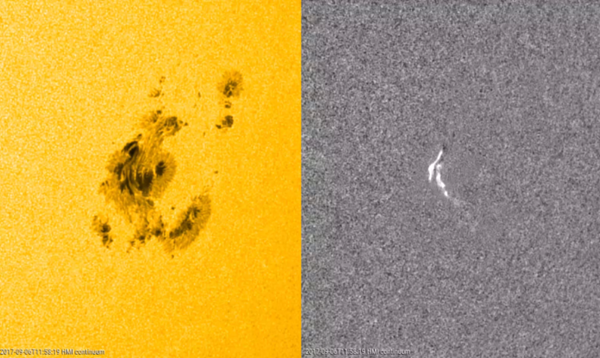
The X9.3 flare peaked on 6 September at 12:02UT. The above images show the SDO/HMI ("white light"; https://sdo.gsfc.nasa.gov/) on the left, and difference images (one HMI image subtracted from the previous) on the right from 11:00 till 13:00UT. Detailed examination of these images show the flare in white light between 11:55 and 12:01UT, making this a rare white-light flare (WLF). The famous Carrington flare back in 1859 was also such a WLF, and there have been only about 100-200 such WLFs observed since then, with solar satellites increasing this number significantly (high cadence observations above the earth's atmosphere). Contrary to the Carrington WLF, which consisted of 2 bright dots, the X9.3 WLF consisted of 2 diffuse ribbons along the magnetic polarity inversion line, i.e. a virtual line separating sunspots of opposite magnetic polarity.
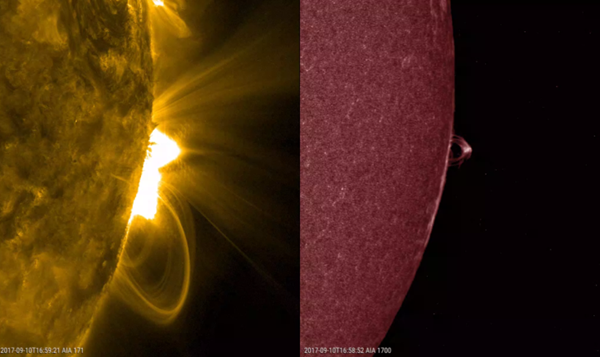
The X8.2 flare peaked on 10 September at 16:06UT, when NOAA 2673 had just rotated over the western solar limb. Yet, impressive, compact and bright post-flare coronal loops developed shortly after the flare. The SDO/AIA 171 images on the left show the flare at temperatures around 700.000 degrees (lower corona), whereas the SDO/AIA 1700 images show the event at temperatures of just a few 1000 degrees in the chromosphere (the Sun's lower atmosphere).
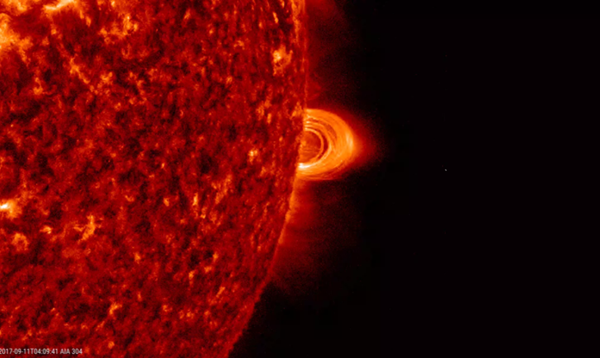
These loops endured nearly a full day, as can be observed in the above SDO/AIA 304 imagery covering 21 hours starting on 10 September at 15:00UT. Here the X8.2 event is shown at temperatures around 80.000 degrees (transition region). There's a remarkable resemblance with the flare of 19 July 2012, which produced loops of a very similar shape (see e.g. http://www.stce.be/news/151/welcome.html and especially http://www.stce.be/news/173/welcome.html for the iconic images). The source region, NOAA 1520, would go on to produce the Carrington-like event on 23 July 2012 (http://www.stce.be/news/152/welcome.html ). The day after the X8.2 event, on 11 September, numerous amateur solar observers were able to observe the still present loops with their small H-alfa telescopes in the red part of the solar spectrum (see also GONG at http://halpha.nso.edu/keep/hav/201709/20170910/ ).
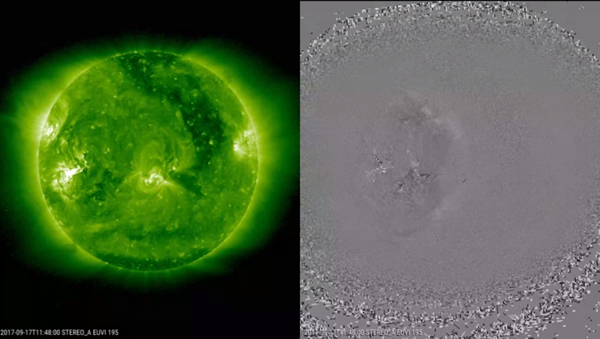
Though NOAA 2673 is now transiting the Sun's far side, it remains active. On 17 September, it produced another quite strong flare (estimated between M4 and X1, so not as strong as the X9 and X8 flares) associated with an impressive coronal wave crashing into a coronal hole. This can be seen in the STEREO-A movie above (https://stereo.gsfc.nasa.gov/ ), with extreme ultraviolet images to the left, and difference images to the right to highlight the subtle details. The coronal hole is the darkgreen elongated structure in the upper-right solar quadrant, NOAA 2673 is the active region in the middle of the eastern solar hemisphere. It appears space weather forecasters need to keep an eye on this bad boy when it will return around 24 September.
Review of solar activity
Flares
Solar flaring activity was very low with only two low C-class flares reported. The source region, for both flares, was the Catania sunspot group 55 (NOAA AR 2680) which had alpha configuration of its photospheric magnetic field during the whole week.
Coronal Mass Ejections, CMEs
Three partial halo CMEs and one full halo CME were observed this week. All these CMEs had a source region on the back side of the Sun (the Catania sunspot group 46, i.e. NOAA AR 2673) as seen from the Earth, and were therefore not Earth directed.
The partial halo CME that was ejected on September 15 came into the field of view of SOHO/LASCO C2 at 19:48 UT, September 15. The CME was very faint and slow, not even detected by CACTUS software.
The second partial halo CME was ejected on September 16 and came into the field of view of SOHO/LASCO C2 at 12:24 UT, September 16. The CME was rather faint. The CACTUS software reported a projected speed of about 400 km/s.
The third CME that was seen was a full halo CME. It came into the field of view of SOHO/LASCO C2 at 12:00 UT, September 17. This was straight after a data gap. The CME was associated with a global EIT wave and a coronal dimming. The CACTUS software estimated a projected speed of about 1300 km/s.
The fourth wide CME observed was a partial halo CME. It came into the field of view of SOHO/LASCO C2 at 14:24 UT, September 17. This CME was also associated with an EIT wave and a coronal dimming. The CACTUS software estimated a projected speed of about 750 km/s.
Below, you see the second, third and fourth CME (left to right) in SOHO/LASCO C2 images. The left image is a difference image, otherwise the CME was almost invisible.

Particle flux
The particle event associated with the M8.2 flare and full halo CME of September 10 was still ongoing. The steep increase of the particle fluxes, with >10 MeV, > 50 MeV as well as > 100 MeV on September 10, 16:30 UT were followed by very a slow decay. The particle flux with > 10 MeV went below the event threshold on September 14, about 18:00 UT.
Below, the particle flux measured by the GOES satellite.
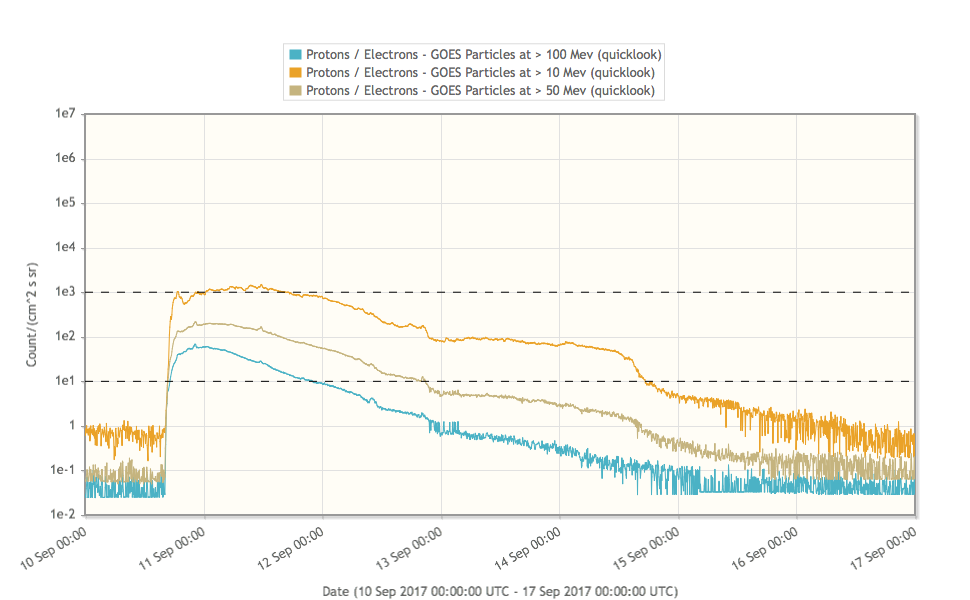
Coronal Holes
We did not observe any coronal hole that could be of importance.
The International Sunspot Number
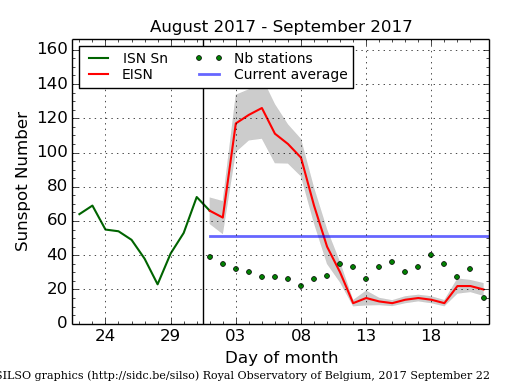
The daily Estimated International Sunspot Number (EISN, red curve with shaded error) derived by a simplified method from real-time data from the worldwide SILSO network. It extends the official Sunspot Number from the full processing of the preceding month (green line). The plot shows the last 30 days (about one solar rotation). The horizontal blue line shows the current monthly average, while the green dots give the number of stations included in the calculation of the EISN for each day.
Review of geomagnetic activity
Shock arrivals
September 12, about 19:20 UT, a jump of the solar wind speed (up to about 540 km/s) and simultaneously an increase of the density and interplanetary magnetic field magnitude (up to 13 nT) was observed. All these indicated the arrival of a shock, probably associated with the partial halo CME that came into the field of view of SOHO/LASCO C2 field on September 9, 23:36 UT.
This shock induced a minor geomagnetic storm during the last 3 hour period of September 12 and the first 3 hour period of September 13 (local station at Dourbes measured K = 5 and NOAA estimated Kp = 5).
A fast forward shock was detected in the solar wind by DSCOVR on September 14, around 00:20 UT. The solar wind data show a clear jump in the speed, density, temperature, and the interplanetary magnetic field magnitude. The solar wind speed in the post-shock sheath was around 390 km/s. This structure in the solar wind is probably linked with limb full halo CME that left the Sun on September 10. The CME was associated with the September 10 X8.2 flare.
The geomagnetic field did not respond.
Fast solar wind
In the second part of September 14, in situ solar wind observations indicated the arrival of a fast solar wind. The speed reached a maximum value of around 700-750 km/s. The fast solar wind was associated with the low-latitude extension of the northern polar coronal hole which reached the central meridian on September 10. The fast solar wind stream carried a southward Bz component of the interplanetary magnetic field. The Earth stayed inside the fast solar wind during the rest of the week.
The fast solar wind stream mentioned above, led to a moderate geomagnetic storm on the planetary level (NOAA reported Kp = 6) in the second part of September 14 and first part of September 15. Only from the third 3 hour interval on September 16, the geomagnetic conditions turned to active and unsettled.
Below, the in situ solar wind data measured by DSCOVR. The top graph shows the solar wind speed in km/s, the second graph shows the strength of the magnetic field and its Bz component.
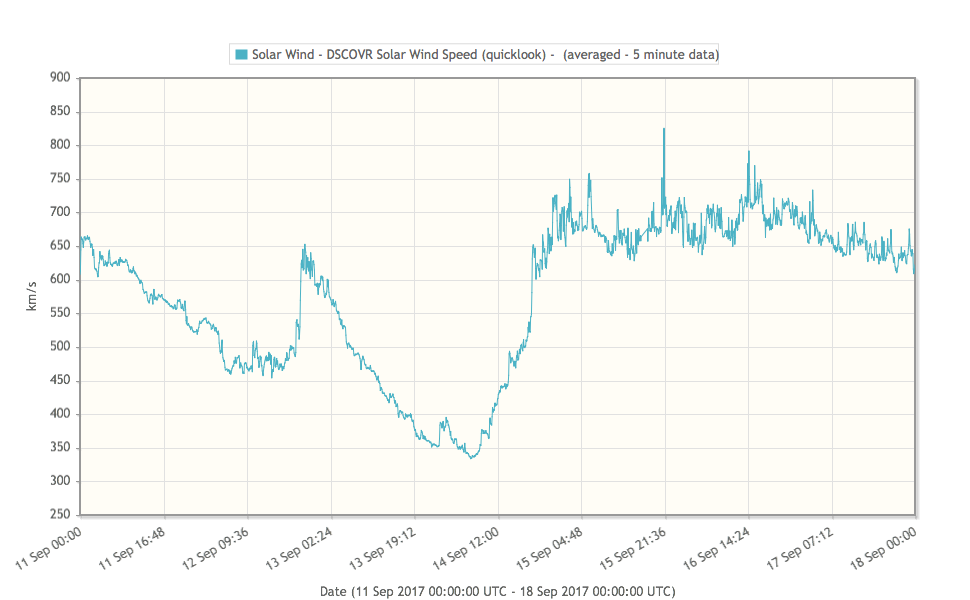
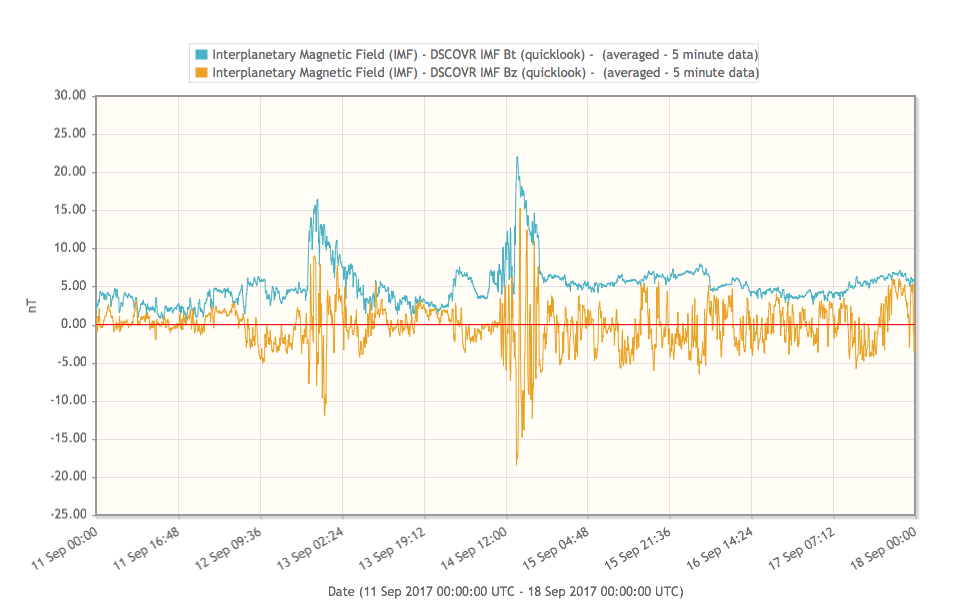
The SIDC Space Weather Briefing
The Space Weather Briefing presented by the forecaster on duty from September 11 to 17. It reflects in images and graphs what is written in the Solar and Geomagnetic Activity report.
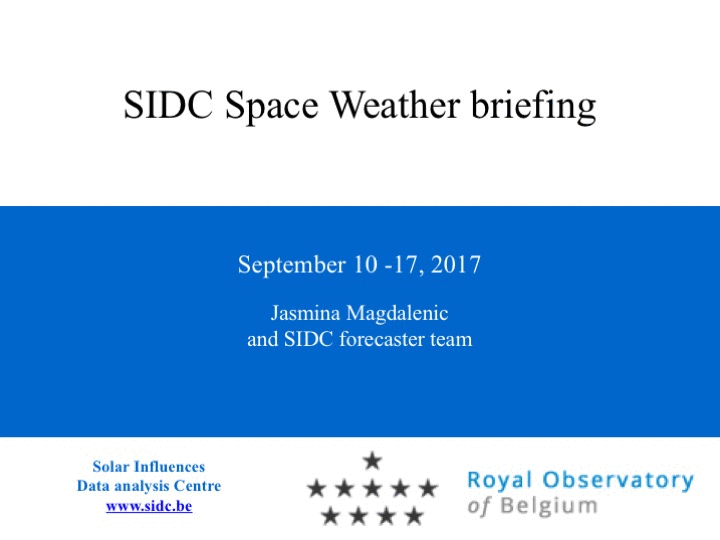
Review of ionospheric activity (11 Sep 2017 - 17 Sep 2017)
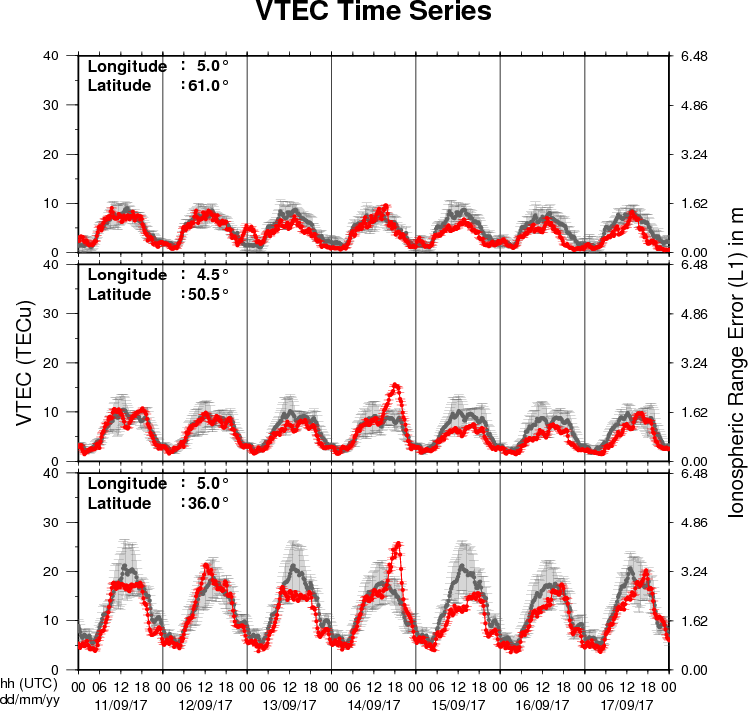
The figure shows the time evolution of the Vertical Total Electron Content (VTEC) (in red) during the last week at three locations:
a) in the northern part of Europe(N61°, 5°E)
b) above Brussels(N50.5°, 4.5°E)
c) in the southern part of Europe(N36°, 5°E)
This figure also shows (in grey) the normal ionospheric behaviour expected based on the median VTEC from the 15 previous days.
The VTEC is expressed in TECu (with TECu=10^16 electrons per square meter) and is directly related to the signal propagation delay due to the ionosphere (in figure: delay on GPS L1 frequency).
The Sun's radiation ionizes the Earth's upper atmosphere, the ionosphere, located from about 60km to 1000km above the Earth's surface.The ionization process in the ionosphere produces ions and free electrons. These electrons perturb the propagation of the GNSS (Global Navigation Satellite System) signals by inducing a so-called ionospheric delay.
See http://stce.be/newsletter/GNSS_final.pdf for some more explanations ; for detailed information, see http://gnss.be/ionosphere_tutorial.php
Future Events
For more details, see http://www.spaceweather.eu/en/event/future
International Workshop on Solar, Heliospheric & Magnetospheric Radioastronomy in Meudon, France
Start : 2017-11-06 - End : 2017-11-10
Jean-Louis Steinbeg has been one of the major pioneers in
radioastronomy. Co-founder of the Nançay Observatory, he
has actively participated to, an inspired a large number of radio
instruments on many international space missions. Jean-Louis
Steinberg is the founder of the Space Radioastronomy laboratory of
the Paris Observatory in 1963. Later on, this laboratory widened
its science interests and became the DESPA (1971) and then the
current LESIA (2002) which is one of the major space sciences
laboratories in France. The aim of this workshop is to cover the
science topics which Jean-Louis Steinberg has promoted during his
career, focusing on Solar, Heliospheric & Magnetospheric
radioastronomy & physics. This will be done by covering both
observations from either ground facilities (NDA, RH, LOFAR, Artemis
etc ...) or space missions (ISSEE, Ulysses, WIND, CLUSTER, STEREO,
CASSINI, JUNO etc ...) and models/theories. A series of invited
talks is also foreseen to cover the new developments in the
discipline which may come with the future facilities such as Solar
Orbiter, Solar Probe Plus, JUICE, JUNO, LOFAR+, SKA etc ....
This workshop will also be the opportunity to remember both the
extraordinary personal & professional lifes of Jean-Louis
Steinberg especially for new generation of scientists. At the
occasion of this workshop it is also expected that the Building 16
(historical Space Sciences building) on the Meudon campus will be
renamed "Building Jean-Louis Steinberg".
Website:
https://jlsworkshop.sciencesconf.org/
European Space Weather Week 14
Start : 2017-11-27 - End : 2017-12-01
The ESWW is the main annual event in the European Space Weather
calendar. It is the European forum for Space Weather as proven by
the high attendance to the past editions. The agenda will be
composed of plenary/parallel sessions, working meetings and
dedicated events for service end-users. The ESWW will again adopt
the central aim of bringing together the diverse groups in Europe
working on different aspects of Space Weather.
Website:
http://www.stce.be/esww14/
